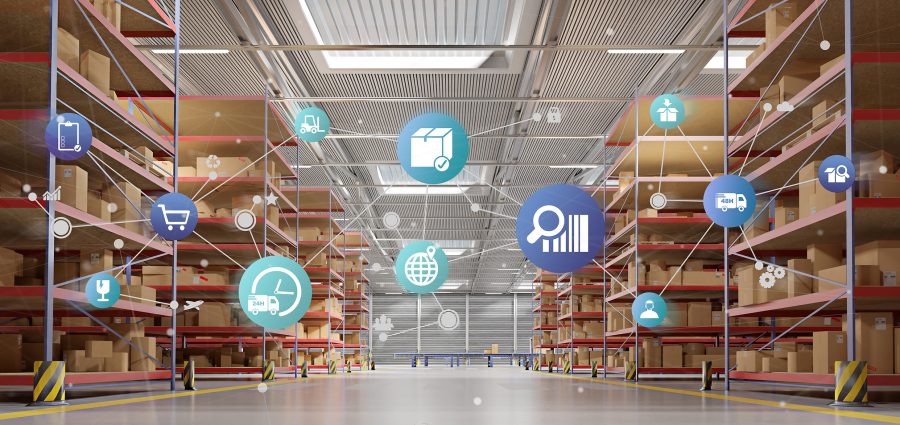In a distribution and manufacturing landscape rife with challenges, automation can play a critical role inside and outside the warehouse. The ability to work faster and smarter allows companies to deliver superior customer service across optimized supply chains. This, combined with real-time data capture, can set smart warehouses apart from the competition.
What is digital automation?
Digital automation continues to be a hot topic in the manufacturing space, yet its meaning can vary greatly based on who you talk to.
Digital automation encompasses a wide variety of technology options to help streamline operations, including:
- Mobile data collection
- Robotics
- Collaborative robots, or cobots
- AI-driven applications
- Robotic process automation
When it comes to implementation, the automation journey gets even more complex, with distributors and manufacturers and their warehouses operating manual systems to fully functioning mobile automation – and everything in between.
The reality is distributors and manufacturers understand the impact digital automation can have on the organization, but are struggling to put it into action. In fact, only 16% of respondents to RFgen’s Digital Inventory Report feel their company’s mobile systems are sufficient to meet current needs.
Reasons to embrace digital automation in your warehouse
For distributors and manufacturers looking to modernize and improve efficiency, digital automation is here to stay. There are a variety of benefits from better data capture, enhanced inventory management and more. Below is a more in-depth look into why more warehouses should embrace it.
Better Data Capture
The success of any distribution or manufacturing entity relies on accurate data. After all, good data equals good decision-making.
Connected devices are key to ensuring reliable, accurate data. That’s why manufacturers must consider barcode scanning, mobile devices and warehouse management solutions. Seventy percent of participants in the Digital Inventory Report say employing these top technologies boosts production and manufacturing efficiencies. Moreover, over half use these types of technologies to streamline outbound warehouse and shipping operations.
Digitally transforming operations through automated technology leads to seamless data flow and real-time information sharing among business-critical systems, resulting in greater efficiency across the product lifecycle.
Enhanced Inventory Management
Some of the top challenges facing distributors and manufacturers involve inventory management, mainly caused by inaccurate inventory data and over/under-stocking of inventory. Coupled with rising input cost, procurement and changes in demand, it’s easy for inventory problems to add up.
Mobile barcoding and other automation technologies can help increase visibility and impact across the warehouse operation by scanning items, parts, and products as they move throughout the lifecycle, allowing distributors and manufacturers to see stock in real-time. With this much visibility into the inventory, these firms are able to become more agile and plan more accurately.
Today, more than 80% of manufacturing and warehouse executives are leaning on barcode scanning and over 50% are focused on mobile devices to help drive efficiencies in inventory automation.
Increased Picking Accuracy
A number of outside factors can hinder a successful warehouse operation, but one of the key culprits is housed within the organization. One example is slow, inefficient warehouse operations and manual (or not optimized) processes that can be devastating to critical business functions.
In a business model that focuses on material availability and real-time data, prioritizing picking methods and automating processes can have a big impact.
Take Schwing America, for instance. When a focus was placed on automating picking methods through mobile barcoding, the result was an increase in picking accuracy by 42%. Today, through automated barcoding solutions, Schwing America’s picking accuracy is a world-class 99.83%, translating into higher order accuracy and fewer costly returns.
Adaptability and Agility in Warehouse Operations
Automation is essential to optimizing processes and meeting the challenge of changing business needs. Automation technologies, like mobile barcoding, have a wider impact on organizations, allowing for easier adaptability.
According to the Digital Inventory Report, surging customer demand is a constant issue for distributors and manufacturers with their warehouses, however, integrating digital automation into an operation allows companies to scale as demands change. Additionally, mobile barcoding software can integrate with robotic solutions to optimize real-time performance. Forward-thinking companies will look at how the industrial Internet of Things (IoT), warehouse robotics and predictive maintenance can all work together to create an interconnected experience that drives accurate, up-to-date data to the organization.
Prioritize Automation in Your Warehouse
Distributors and manufacturers are constantly impacted by changing demands and economic realities. While some are out of the company’s control, prioritizing digital automation can help give organizations a step up on the competition.
Automation and mobile barcoding enable streamlined data capture to drive informed decision-making and the necessary operational adjustments. In the end, prioritizing a mobile experience will bolster the product and supply chain lifecycle, resulting in a more successful and efficient warehouse.
Related Posts
-
Robert Brice discusses how digital and automation technology can help deal with challenges faced by…
-
The new facility in the town of Dacono is the company’s second location outside of…
-
The company appointed Sofia Sirvell as CDO for the Sandvik Group and new member of…






